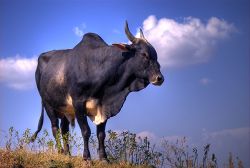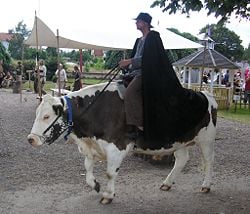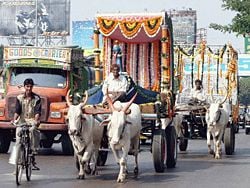Ox
- This article is about the animal. For other uses of the terms ox or oxen, see Ox (disambiguation).
Oxen (singular ox) are cattle trained as draft animals. Often they are adult, castrated males. In New England and Maritime Canada, the term oxen refers to trained steers at least four years of age. Prior to age four they are referred to as handy steers. Oxen are used for plowing, transport, hauling cargo, threshing grain by trampling, powering machines for grinding grain, irrigation or other purposes, and drawing carts and wagons. Oxen were commonly used to skid logs in forests, and sometimes still are, in low-impact select-cut logging. Oxen are most often used in teams of two, paired, for light work such as carting. In the past, teams might have been larger, with some teams exceeding twenty animals when used for logging.
- An adult female over two years of age (approximately) is called a cow. An adult, intact (not castrated) male is called a bull. Young cattle are called calves. A young male is called a bull calf; a young female before she has calved the second time is called a heifer (pronounced "heffer"). A young female that has had only one calf is sometimes called a "first-calf heifer." In the United States, male cattle bred for meat are castrated unless needed for breeding. The castrated male is then called a bullock or steer, unless kept for draft purposes, in which case it is called an ox (plural oxen), not to be confused with the related wild musk ox. A male cow is called a stag if it is castrated as an adult. The adjective applying to cattle is bovine.
Raising

In order to become oxen, the cattle must learn to respond appropriately to the teamster's (ox driver's) signals. These signals are given by verbal command, body language, and the use of a goad stick or whip. In preindustrial times, many teamsters were known for their voices and language. In North America, the most common verbal commands are (1) get up (go), (2) whoa (stop), (3) back up, (4) gee (turn to the right) and (5) haw (turn to the left). In the New England tradition, oxen must be painstakingly trained from a young age. Their teamster must make or buy as many as a dozen yokes of different sizes as the animals grow.
In other countries and ox training traditions, adult cattle with little or no prior human conditioning are often yoked and trained as oxen. This is done for economy, as it is easier to let a calf be raised by its mother, and for lack of adequate methods for housing and feeding young calves.
A tradition in south eastern England was to use oxen (often Sussex cattle) as dual-purpose animals: for draft and beef. A plowing team of eight oxen consisted of four pairs aged a year apart. Every year, a pair of steers would be bought at about three years of age, and trained with the older animals. The pair would be kept for four years, then at about seven years old they would be sold to be fattened for beef – thus covering much of the cost of buying the new pair. Use of oxen for plowing survived in some areas of England (such as the South Downs) until the early twentieth century[1].
Ox trainers favor larger animals for their ability to do more work. Oxen are therefore usually of larger breeds, and are usually males, because castrated males are generally larger – females can also be trained as oxen, but as well as being smaller, they are often more useful for producing calves and milk. Fertile males (bulls) are also used in many parts of the world.

Use
Oxen can pull harder and longer than horses, particularly on obstinate or almost un-movable loads. This is one of the reasons that teams were dragging logs from forests long after horses had taken over most other draught uses in Europe and North America. Though not as fast as horses, they are less prone to injury because they are more sure-footed and do not try to jerk the load.
"Japanese ox" is an Australian term used for grain fed steers in the weight range of 500 to 650kg that are destined for the Japanese meat trade.[2]
See also
- Bullock cart
- Plough
- Ridge and furrow
- Oxtail
ReferencesISBN links support NWE through referral fees
External links
Credits
New World Encyclopedia writers and editors rewrote and completed the Wikipedia article in accordance with New World Encyclopedia standards. This article abides by terms of the Creative Commons CC-by-sa 3.0 License (CC-by-sa), which may be used and disseminated with proper attribution. Credit is due under the terms of this license that can reference both the New World Encyclopedia contributors and the selfless volunteer contributors of the Wikimedia Foundation. To cite this article click here for a list of acceptable citing formats.The history of earlier contributions by wikipedians is accessible to researchers here:
The history of this article since it was imported to New World Encyclopedia:
Note: Some restrictions may apply to use of individual images which are separately licensed.
